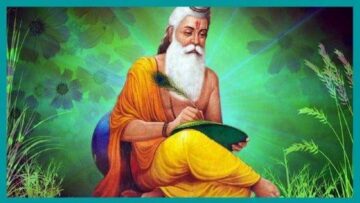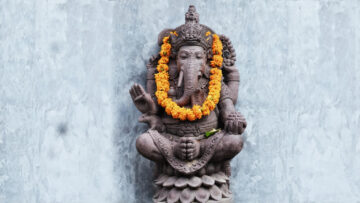Abstract
This article proposes that environmentalism and sustainability are engrained in the ancient civilization of India – as a consequence of its philosophical framework. The Purushartha framework guides every aspect of life in India. Artha and Kama result in exploitation of resources to satisfy desires and needs. But Dharma ensures that there is balance of all sorts that beholds life. Environmentalism and sustainability are engrained into this balance of Dharma. However, Dharma too does not sustain itself without Moksha – renunciation. Hence, entire framework of Purushartha becomes important. This framework itself emanates from the unique philosophy of Srishti-Sthi-Laya and their interrelations. The dynamic of the universe, the cause of Artha and Kama, is imagined through these concepts. Hence, Environmentalism and Sustainability are a consequence of a framework that guides daily life, backed by an imaginative philosophy, unique to Indic civilization.
The Vision of the Purusharthas
The vision of the Purusharthas and their inter-relationships is a unique contribution from India to the World. It has four elements – Dharma, Artha, Kama and Moksha – often pronounced in this sequence. [Very few other frameworks or philosophies look at all four of these in the same vein]. This article presents only salient features of these elements assuming a familiarity of the basics. The salient features are:
- Artha (Security) and Kama (Desire) that are mostly in the material world are dealt with seriousness and respect equal to the spiritual element of Moksha (Liberation).
- Artha is not defined in the limited sense of wealth. It has both material and mental/psychological components. Wealth, Security, Meaning, Health etc., everything that is essential to the happiness of life comes under its ambit. The ashTa-lakShmi concept bears testimony to it.
- Kama is the broad desire and fascination that is undeniable aspect of human life. It is not looked down upon. Man has a right to seek his desire and fascination even when there is no larger purpose, but they have limitations and need to be governed by dharma. Without desires and fascinations well addressed, exploration of dharma and attainment of moksha becomes impossible and this reality is recognized. Few cultures have treated these elements in the same way as Indian philosophy does, without a sense of apology and at the same level as spirituality.
- Dharma (The beholding balance) binds all of them and creates a balance in the overall life. Without Dharma (the balance) Artha and Kama get into slippery territory. Our epics portray this in such breadth and depth that this does not need much explanation.
Without Moksha sustaining Dharma is very difficult. This last point is extremely critical. The roots of everything else lies in the way Moksha is imagined and then how that imagination sustains Dharma and the implications of all of that.
In this, the tradition is heavily biased in favour of ‘action’ than ‘knowledge’. Tradition does not say that one should knowingly perform those righteous actions (good path actions) or that one should be knowledgeable about Dharma and Moksha. If one manages to live one’s artha and kama in a sustainable way and without creating conflict – then that is nothing but Dharma itself. Essentially, one need not know Dharma deeply to be truly dharmic. Hence the tradition does not burden people with a philosophical overload. In that path, one can attain moksha. Tradition is full of stories where commoners attain moksha and are revered as great dharmic persons by just living their common lives with sincerity and honesty. Eg., Dharmavyaadha story of Mahabharata.
Tradition just says that without dharma, the Artha (our securities of life) and Kama (desire) will go awry. Indian wisdom says that Artha and Kaama have the inherent tendency to go uncontrolled and create havoc. One’s artha and kama will clash with another’s and will invariably create conflict. Make no mistake, they are not to be disrespected, they are to be fulfilled – they are at the same pedestal as Dharma, Moksha as a fundamental aspect of life. However, tradition makes two very fundamental points.
The nature of conflicts in artha, kama is such that -constantly striving to be on a righteous path is essential for a human being in order to not go astray in those conflicts. Beyond that, even the most righteous path/action (Dharma) is impossible to achieve or perform with consistency – without a sense of Moksha – which includes a sense of renunciation, abdication, not building stakes etc., – and striving for the same. Eg., Kartaveeryarjuna stands as an example
This last point is a unique wisdom and is fundamental to Indian Philosophy and tradition.
The Concern of the Purushartha Framework
Before we dwell upon the philosophical essence that leads to sustainability and environmentalism, let us understand the concern of the Purushartha framework. Its concern is to enable a fulfilling life in the most sustainable manner, create a framework of life that enables such fulfillment in most equitable and sustainable manner for an entire society – today and tomorrow. The present is the primary concern of this philosophy but without losing sight of the future. The objective is to lead a beautiful today and prepare a sustainable tomorrow. This indirectly explains why grihastha dharma holds the kind of importance and respect it does in tradition. It will not be an exaggeration to say that a grihastha sustains life and dharma/moksha for all in the society. Sanyasa is sustained by the grihastha.
In summary, the concern of Dharma and Moksha is to create a sustainable Artha and Kama for humanity. The concern is to create a sustainable life. This ensures that the material is for the spiritual and the spiritual is for the material – it is mutually dependent and mutually enabling. Thus, the framework encompasses all aspects of life.
This framework is not arising out of thin air. It is the result of a unique vision of the Universe. This vision too is not arising out of an ideological approach towards life, neither is it merely an intellectual vision. This vision is the result of a deep contemplation – what we uniquely call in India as tapas – it is a unique way of perceiving the reality of the universe. Such a tapas can only be performed only when the senses are under control in the path of renunciation. This vision of the universe though can be validated, through experience, in the mortal material world as well. In this way, both the vision and collective set of methods (tapasya) that gave us this vision are unique to India and of far reaching consequence. It can be explained as a set of fundamental realities that can be validated through experience.
Vedic Vision: Sthiti – The Universe is Constantly in Motion undergoing Change yet in Equilibrium
The traditional Indian world is often accused of being allergic to change. This is an incorrect understanding. Indian traditions are designed for change.
In the modern world, there is a saying that nothing is constant except the change itself – there is the Universe and then there is the change. The Indian Philosophy recognizes this differently. Its fundamental elements are –
- The Universe is in constant motion and continuously undergoing change. Yet, it is in an Equilibrium – in each of its changed position or it should be – this natural state is called as Sthiti.
- Change is a fundamental reality acknowledged by Indian Philosophy and is at its core. Change is an essential dynamic of the Universe.
- The fact that Kama (Fascination and Desire) and Artha (Money, Wealth, Security) have the same status as Dharma and Moksha are a recognition of Change being fundamental as they are the instruments of Change.
- The nature of change and how we must negotiate this change in different ways are entirely different from the Modern ways. (Crux of this article).
Environmentalism and Sustainability flows from this perspective of change.
Vedic Vision: Rta – Fundamental Principles that determine the Natural Flow of the Universe
In the Indian Vedic perspective, Change in the Universe is shaped by certain Fundamental Principles of Natural Flow. These principles are together referred to as ‘Rta’. This also recognizes a critical importance of the root-word (dhAtu) of Rta ie., Ru. Rta is explained as “That tatva that determines the flow of the Universe – hence change”. They determine how the Universe changes continuously. They are not easy to comprehend. It requires Tapas to perceive them in their fullest.
It is important to note that Rta is not the Flow itself ie., the Flow itself is not predetermined completely. It is the set of Fundamental Principles that determines the Flow. At each stage in the Universe, there are many possibilities for this Flow. The collective of Time, Space and Human Actions then determine the actual Flow in accordance to these Principles. As a result, The Flow is imagined as a Directed Graph – from each node many different paths emerge all of which are according to Rta.
Now for the critical element. This Vision accords a power to human actions usually not found in philosophies. Human Beings are accorded the freedom to positively or negatively impact Rta. The Right Actions result in life following one of those Natural Flow Paths. The Wrong Actions result in straying away from the paths of Rta – large scale straying away leads to Large destructions that could be termed as Pralaya. Thus, acting in accordance to Rta results in the beholding of the Universe and straying away from Rta results in things falling apart. Our actions result in the implications they deserve.
This also is a key principle behind the traditions of India. They have evolved gradually in accordance to this principle – bit by bit rather than a top-down design, until recently that is. This also brings us to recognize another oft-ignored aspect of our tradition. Human beings have enormous freedom and with freedom comes responsibility. Tradition does not seek to take this freedom away. But it certainly intends to guide and channelize it in the direction of Rta.
Vedic Vision: The Role of a Rishi
Given the importance of Rta it is only natural that the tradition values those who can see and perceive Rta. If a society is organized on a principle, then one needs a critical set of people who can perceive, protect and negotiate this principle and enable the larger society to live in accordance and appreciate the principle. Rishi is that enlightened person who can perceive the difficult-to-comprehend-Rta in entirety. He is knowledgeable in the past, present and the future. He can see the paths and Natural Flows of Rta. He can determine the result of various actions and evaluate if those are accordance to Rta.
However, this insightful power can only be achieved through penance, austerity and absolute control of the senses – as these are not writable laws that can be merely comprehended by the intellect. Hence, India has from time immemorial valued and endeavored to nurture, protect people who have a vision far beyond, who are selfless and who have given up the path of the senses so that they can achieve the psychic powers of a Rishi.
Vedic Vision: The Sthiti
This kind of change – where the Universe is in constant motion changing itself according to a set of principles – is naturally characterized by the creation of the new and destruction of the past in terms of the material and the mind. As a result, Mankind’s primary concern must be to negotiate this change in accordance to Rta and not otherwise – for human actions are capable of the latter.
While the Principles governing the Flow are collectively referred to as Rta, the Flow itself is referred to in our philosophy as ‘Sthiti’. Sthiti is normally translated as the ‘State’ and the State is characterized as being dynamic yet it a path of stable equilibrium. Let us call it “The Dynamic Stable equilibrium” ie., it is stable, the stability is one of equilibrium and yet it is dynamic. Dynamic means it is constantly changing. Equilibrium means even while it is changing, each new state it attains is in a state of balance and not unstable. It represents a certain harmony and a good state for life to thrive. We can represent this with the analogy of Boat Travel over the Ocean from one Island to another Island. In each Island the boat can rest and is in balance. There is a path going out from each Island and hence it is dynamic. This state is called Sthiti in Sanskrit. This is the Lord Vishnu or Narayana state for some. This is the perfect state, and this is how the world should be.
Vedic Vision: The Srishti
What about the creation then? Creation ie., Sristhi is natural and necessary without which there is no dynamism that defines Sthiti. However, it cannot disturb the dynamic equilibrium in this sthiti governed by Rta. That then is the boundary for Creation – Srishti. It cannot be mindless, cannot go awry. Every bit of creation is not celebrated, what moves it forward in one of the Paths of Rta is celebrated. This conceptualization of the world has critical implication. Srishti – the creation – is not independently venerated. It is valued in its boundary of ensuring that the world continues to be dynamic but in a stable equilibrium. It is essentially subordinated to Sthiti in such a way that it has unbridled freedom within but undesirable to step outside the boundary. Srishti is that positive dynamic force that enables change through novelty. It is required to move from one island to another island, to create new boats and explore new routes. Laya is that dynamic force that ends an object of previous creation, creating space for the new. It is required to destroy old boats so that new boats are created for new paths. It is required to abandon a bad path to make the right path more accessible.
Vedic Vision: The grand balance between Srishti, Sthiti and Laya
However, some paths from one island to another and so on are always perfect – not just good. Such paths are called the paths of Rta. Those who know such paths are Rishis. Those who can always be on such paths without getting concerned about the remaining are in the state of Moksha. For the Vaishnavite, they are in the Vishnu or Narayana state. Dharma, then, is nothing but an infinite set of actions that help us keep ourselves in the good and perfect paths. The Sanskrit meaning of Dharma is The Beholder – the one that keeps things together – the breakup in Sanskrit for Dharma is “dhaarayati iti dharma” – dhaarayati is to hold.
Under this broad definition, there is absolute freedom for an individual to explore paths and actions – this is the freedom that Indian tradition offers to an individual. This is the philosophical exposition of the concept of Moksha.
This, in turn, means a recognition two other aspects.
- Srishti does not always create a perfect boat. Hence, Laya steps in and destroys the unwanted.
- Srishti often takes universe in wrong directions. There are bad paths. Laya steps in and corrects.
What ensures that the Sristi does not hurt the stable equilibrium through its dynamism? It is the Laya ie., destruction. It ensures that Sthiti does not overdo its role. It ends that which obstructs the creation of the new (because sthiti is dynamic). It also creates large scale destruction when sthiti goes awry and ends up creating something that obstructs the Natural Flow ie., Rta
– like the Nature’s Fury for our environmental misadventures.
Hence the primacy for Sthiti. Srishti and Laya are encompassed within this Sthiti. There are serious implications of this philosophy in the world views of our people and how the civilization has evolved. India has never viewed the concept of Progress in an independent way – in particular, the material progress. Progress is necessary not as an independent value in the Universe but essential to ensure that we are in a dynamic state of equilibrium – it’s a subordinate value. The material world is not progress but a mere change but towards being in the dynamic stable equilibrium. Change is valued but it is not necessarily Progress and Progress is not an independently valued – it is its ability to be in balance with Rta that is celebrated. Gross Domestic Product will never attain the kind of primacy in this world view – I shall elaborate this in a subsequent article.
Environmentalism and Sustainability as a consequence of the nature of Srishti
The net result of all this is – India never viewed the Universe and Life as in a motion in a single dimension. The Universe never needed to be bettered. This Universe, that was already in constant motion, should always be in the Sthiti – represented by Lord Vishnu. Since it never needs be bettered, there was no sense of Universal Progress for the World. However, the Universe is constantly in change/motion and it is the responsibility of humanity to ensure that it is in Sthiti, by respecting creation, indulge in creation but ensure that they were not in conflict with Rta ie., ensure that Srishti is aiding Sthiti.
This means the aspiration of mankind should be to attain Sthiti and that is the progress for the individual. Hence, primarily, progress was not defined for the Universe but for the individual in the Indian civilization. The Individual should aspire to attain the state of sthiti and act according to dharma so that the Natural Flow of Universe (Rta) is never disturbed and the Universe is in Sthiti.
This leads to the following conclusions
- Since a Universal notion of progress is not defined for the larger world, it does not mean that the philosophy looked down upon the material world. Any progress in the material world is a relative progress. It may or may not lead to the progress of the individual which is primary. It is part of Artha and Kama. The Purusharthas contain Kama and Artha, representing progress in the material world, valued at the same level of Dharma and Moksha. This means we view the Material World as Fascination, Desire, Meaning and Security – we are entitled to that and we must pursue. However, we must ensure that our Fascinations dont drive our Worlds/Universes outside the path of the Natural Flow of Sthiti. We ensure this through Dharma and here we find the modern notion of sustainability as being a natural outcome in this philosophy.
- What makes this more robust is the relationship between Dharma and Moksha. We cannot sustain such a balanced exploration of life (Dharma, Artha, Kama) without the ambition of attaining Moksha. Mere chasing material goals – even within the Dharma – will someday throw us out of the path of Dharma.
- Thus, the subservient nature of Artha and Kama means a limited role of Srishti as serving the cause of Sthiti – that is the root of sustainability and environmentalism in India – as natural outcomes. Srishti is never derided as that is an integral element within Sthiti. It is a nature of Sthiti. Sthiti does not remain in the same balanced state but to move to another balanced state. Hence, Srishti is necessary and hence the creation of new things, hence the utilization of resources of the universe. Yet the new state must be balanced and hence the limit to creation and hence a limited use of resources only for the purpose of Srishti – Kama and Artha are contained in Srishti. All creation and use of resources is part of Kama and Artha which are within Srishti and which is subservient to Sthiti.
- In life, the balance on creation (artha, kama) is brought by the running parallel of renunciation to achieve Moksha. The purpose of life is to realize beauty every single day and achieve Moksha. Beauty is defined in both the indulge of artha and kama as well as in the path of renunciation to achieve Moksha. Hence, it is this philosophy that makes sustainability and environmentalism a natural outcome.
The tradition emphasizes that such a life needs intense reflection and deliberation. Along with it, the tradition also provides for a unique/definite architecture and organization of society and life is required for us to live a righteous path and strive for Moksha. Without such an architecture of life, it is difficult for an individual to pursue such a path on one’s own – in particular, for the commoner it becomes difficult. The tradition has strived to create such an architecture of life. Construction of such an architecture requires discipline, foresight and intellect – all attributes of great sages – The Rishis. Knowing about them either intellectually or otherwise or increasing our awareness of the same – increases our ability to strive towards them. It is this philosophy and traditions arising out of it that has made Sustainability an integral and natural element of our civilization.
What then is Dharma?
Dharma then becomes the collection of all those acts that are in accordance to Rta and maintain sthiti.
- Acts of Srishti that ensures change in the path of Rta and ensures Sthithi then become Dharma.
- All the good human deeds then become dharma naturally.
- Hard tough actions of Laya that then protects sthiti are dharma as well. (Kurukshetra battle was one such example)
This definition of Dharma makes it an Exploration rather than a Law. An Act of Dharma is always valued for its impact on sthiti of the day. Hence, it naturally becomes a function of “Today” and “the set of paths of Natural Flow available in front of us that day”. Hence, Dharma cannot be reduced to a set of dogmatic laws that are eternally true. Dharma is based on a set of universal principles without doubts. But it is always guided by what is the outcome or the possible outcomes. Hence, it is a function of time, space and universal principles. This explains the reality that India has never had a single law book for all times. Further, it has never depended on a single Law book in any time in history. India has always relied on an ever-evolving set of customs and traditions – different one for each community. It has looked upto the Epics forever. It has indeed written lawbooks but has constantly changed it overtime – we now have atleast 40 lawbooks of the past available to us with no guarantee that any of that was in full vogue in any region of the country. This also explains why the Constitution of India in 1947 was accepted without much ado. Universal laws were abhorred by Indians, but Universal Principles have always been explored.
What then is Moksha?
Moksha is that state of a liberated mind where one continues to perform all righteous actions of life yet unaffected by the results and implications of the actions. In this state, one is equidistant from everything in the world. Everything is important but nothing is important. Everything and nothing belong to such an individual. You can do anything without an after-effect on the self. When one attains this state, one earns the ability to observe everything from a distance, without being involved in it. It is a unique path and journey in life that is right in front of all of us but only few can recognize and pursue. This also has another notable implication. It is attainable while you are alive – the term called “Jeevanmukta”, meaning alive but liberated, represents this reality. Buddha and Paramahamsa et.al. achieved that state. When we say one has attained this after death, it means many things. For our discussion, it suffices to say that it refers to a brilliant footprint left behind that makes such a path accessible to large sections of humanity. Thus far – we have discussed it as a concept which is comprehensible in material terms to an extent and its attainability at a theoretical/in-principle level.
But, practically, how can one achieve this? Is a need for deep scholarly exposition mandatory, does one have to be an intellectual or a indulge in tough, ascetic kind of life? Here, the Indian tradition is amazingly open. One can attain this state in any which way. In principle, a football player can achieve this even while he is playing. A highly materialistic person can stumble upon this path, suddenly. A common man/woman can find this path within one’s routine life. Of course, tradition also has created multitude of techniques some of which are yogic in nature, in order to arrive at this path. It is a real, attainable state in one’s lifetime and the opportunities available to do so are equal for all irrespective of the background. A mendicant, king, businessman or a farmer or even someone perceived to be the lowest in the social ladder – all of them have near equal chance and opportunity, in principle, to achieve this state.
It is this firm faith in the achievability of this state of moksha, beauty of life in the path of its achievement and the entire society directed towards moksha that makes dharma, artha, kama sustainable and real in Indian society. Dharma guides and bounds Artha, Kama which then ensures sustainability and ensures Sristhi and Laya are in the direction of Sthiti. Such is the role of Purusharthas in realizing Sustainability and Environmentalism.
Summary
Sthiti means a state of dynamic stable equilibrium. It contains Srishti and Laya within it for the purpose of Sthiti. In this philosophy, universe is in a constant creative motion which can be described as dynamic stable equilibrium. This motion is governed by Universal Principles – Rta. Artha, Kama ensure creation and Dharma ensures that they are in the Path of Rta. Dharma itself is unsustainable without moksha which is nothing but a state of Sthiti. Achieving moksha needs renunciation and this path of life is beautiful.
In this definition of life, it ensures the following:
- Progress primarily is defined for the individual and that is attaining moksha. Artha, Kama that drive material development are subservient to moksha and hence sustainability is fundamentally engrained in the perspective of life. It limits the need for material.
- Universal/Absolute Progress is not defined for the society or the material in isolation, it is only a relative progress. This ensures that material development is not an independent value that must be pursued with passion. It is needed for only desires, fascination, security and for dharma and moksha. This limits the need for material and hence sustainability.
This perspective of life also results in Community Life, Diversity but they are outside the scope of this article.
Disclaimer: The opinions expressed in this article belong to the author. Indic Today is neither responsible nor liable for the accuracy, completeness, suitability, or validity of any information in the article.











